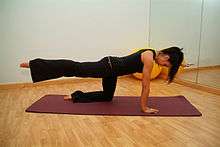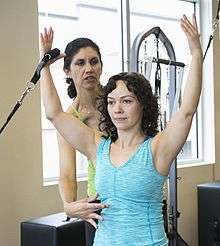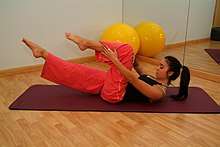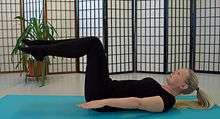Pilates
Pilates (/pɪˈlɑːtɪz/;[1] German: [piˈlaːtəs]) is a physical fitness system developed in the early 20th century by Joseph Pilates, after whom it was named. Pilates called his method "Contrology".[2] It is practiced worldwide, especially in Western countries such as Australia, Canada, the United States and the United Kingdom. As of 2005, there were 11 million people practicing the discipline regularly and 14,000 instructors in the United States.[3]

Pilates developed in the aftermath of the late 19th century physical culture of exercising in order to alleviate ill health. There is however only limited evidence to support the use of Pilates to alleviate problems such as lower back pain.[4] Evidence from studies show that while Pilates improves balance, it has not been shown to be an effective treatment for any medical condition[5] other than evidence that regular Pilates sessions can help muscle conditioning in healthy adults, when compared to doing no exercise.[6]
Brief description

In his book Return to Life through Contrology,[2] Joseph Pilates presents his method as the art of controlled movements, which should look and feel like a workout (not a therapy) when properly manifested. If practiced with consistency, Pilates improves flexibility, builds strength and develops control and endurance in the entire body.[7] It puts emphasis on alignment, breathing, developing a strong core, and improving coordination and balance. The core, consisting of the muscles of the abdomen, low back, and hips, is often called the "powerhouse" and is thought to be the key to a person's stability.[8] Pilates' system allows for different exercises to be modified in range of difficulty from beginner to advanced or to any other level, and also in terms of the instructor and practitioner's specific goals and/or limitations. Intensity can be increased over time as the body adapts itself to the exercises.[7]
History
Pilates was developed by Joseph Pilates, from Mönchengladbach, Germany. His father was a gymnast and his mother a naturopath.
During the first half of the twentieth century, he developed a system of exercises which were intended to strengthen the human mind and body. Pilates believed that mental and physical health were interrelated.[9]
In his youth he had practiced many of the physical training regimes available in Germany, and it was from these he developed his own method. It has clear connections with the physical culture of the late nineteenth century, such as the use of special apparatuses and claims that the exercises could cure ill health. It is also related to the tradition of "corrective exercise" or "medical gymnastics" as typified by Pehr Henrik Ling.
Pilates said that the inspiration for his method came to him during World War One, while he was being held at the Knockaloe internment camp on the Isle of Man.[10] He developed his method there for four years, working on his fellow internees [10].

Joseph Pilates accompanied his method with a variety of equipment, for which he used the term "apparatus". Each apparatus was designed to help accelerate the process of stretching, strengthening, body alignment and increased core strength started by the mat work. The best-known and most popular apparatus today, the Reformer, was originally called the Universal Reformer, aptly named for "universally reforming the body". Eventually Pilates designed other apparatus, including the Cadillac, Wunda Chair, High "Electric" Chair, Spine Corrector, Ladder Barrel and Pedi-Pole.[9]
Pilates published two books related to his training method: Your Health: A Corrective System of Exercising That Revolutionizes the Entire Field of Physical Education in 1934, and Return to Life Through Contrology in 1945.
His first students went on to teach his methods, including: Romana Kryzanowska, Kathy Grant, Jay Grimes, Ron Fletcher, Mary Bowen, Carola Treir, Bob Seed, Eve Gentry, Bruce King, Lolita San Miguel, and Mary Pilates, Joseph's niece. Contemporary Pilates includes both the "Modern" Pilates and the "Classical/Traditional" Pilates. Modern Pilates is partly derived from the teaching of some first generation students, while Classical Pilates aims to preserve the original work as Joseph Pilates taught it.
Principles
A number of versions of Pilates are taught today and the majority are based on up to nine principles.[8] Frank Philip Friedman and Gail Eisen, two students of Romana Kryzanowska, published the first modern book on Pilates, The Pilates Method of Physical and Mental Conditioning, in 1980 and in it they outlined six "principles of Pilates".[11] These have been widely adopted—and adapted—by the wider community. The original six principles were concentration, control, center, flow, precision, and breathing.
Breathing

Breathing is important in the Pilates method. In Return to Life, Pilates devotes a section of his introduction specifically to breathing "bodily house-cleaning with blood circulation".[12] He saw considerable value in increasing the intake of oxygen and the circulation of this oxygenated blood to every part of the body. This he saw as cleansing and invigorating. Proper full inhalation and complete exhalation were key to this.[11] He advised people to squeeze out the lungs as they would wring a wet towel dry.[2] In Pilates exercises, the practitioner breathes out with the effort and in on the return.[11] In order to keep the lower abdominals close to the spine, the breathing needs to be directed laterally, into the lower rib cage. Pilates breathing is described as a posterior lateral breathing, meaning that the practitioner is instructed to breathe deep into the back and sides of his or her rib cage. When practitioners exhale, they are instructed to note the engagement of their deep abdominal and pelvic floor muscles and maintain this engagement as they inhale. Pilates attempts to properly coordinate this breathing practice with movement.
Concentration
Pilates demands intense focus, the way that exercises are done is more important than the exercises themselves.[11]
Control

"Contrology" was Joseph Pilates' preferred name for his method, and it was based on the idea of muscle control.[11] All exercises are done with control, the muscles working to lift against gravity and the resistance of the springs and thereby control the movement of the body and the apparatus.[11]
Centering
For practitioners to control their bodies, they must have a starting place: the center. The center is the focal point of the Pilates method.[11] Many Pilates teachers refer to the group of muscles in the center of the body—encompassing the abdomen, lower and upper back, hips, buttocks, and inner thighs—as the "powerhouse". All movement in Pilates should begin from the center and move outward to the limbs.
Flow
Pilates aims for elegant economy of movement, creating flow through the use of appropriate transitions. Once precision has been achieved, the exercises are intended to flow within and into each other in order to build strength and stamina. In other words, the Pilates technique asserts that physical energy exerted from the center should coordinate movements of the extremities.[11]
Postural alignment
Using correct posture while doing Pilates exercises improves safety by correcting muscle imbalances and optimizing coordination.[8]
Precision
Precision is essential to correct Pilates.[2] The focus is on doing one precise and perfect movement, rather than many halfhearted ones. Here Pilates reflects common physical culture wisdom, gaining more from a few energetic efforts than from many listless ones.[13] The goal is for this precision to eventually become second nature and carry over into everyday life as grace and economy of movement.[2]

Relaxation
Correct muscle firing patterns and improved mental concentration are enhanced with relaxation.[8]
Stamina
With increased precision, motion becomes more efficient so there is less stress to perform the exercises.[8]
Effectiveness
In 2015 the Australian Government's Department of Health published a meta study which reviewed the existing literature on 17 alternative therapies including Pilates, in order to determine if any were suitable for being covered by health insurance. The review found that due to the small number and methodologically limited nature of the existing studies, the effectiveness of Pilates is uncertain.[5] Accordingly, in 2017, the Australian government named Pilates a practice that would not qualify for insurance subsidy, saying this step would "ensure taxpayer funds are expended appropriately and not directed to therapies lacking evidence".[14]
For the treatment of lower back pain, low quality evidence suggests that while Pilates is better than doing nothing, it is no more effective than other forms of physical exercise.[15][4] There is some evidence regular sessions can help with the conditioning of the abdominal muscles of healthy people, when compared to doing no exercise.[6] There is no good evidence it helps improve balance in elderly people.[16]
Legal status
Pilates (the therapy version) is not professionally regulated.[17]
In October 2000 "Pilates" was ruled a generic term by a U.S. federal court, making it free for unrestricted use.[18] The term is still capitalized in writing, due to its origin from the proper name of the method's founder.[19]
As a result of the court ruling, the Pilates Method Alliance was formed as a professional association for the Pilates community. Its purpose was to provide an international organization to connect teachers, teacher trainers, studios, and facilities dedicated to preserving and enhancing the legacy of Joseph H. Pilates and his exercise method by establishing standards, encouraging unity, and promoting professionalism.[20]
Comparison with yoga
Modern yoga, like Pilates, is a mind-and-body discipline, though yoga classes are more likely to address spiritual aspects explicitly. Some poses are similar in the two disciplines; for example, open leg balance closely resembles Navasana, boat pose; roll over is similar to Halasana, plough pose; and swan and push-up are essentially identical to Bhujangasana, cobra pose and Chaturanga Dandasana, low plank pose, respectively. Both disciplines develop strength, flexibility, and fitness. Pilates, however, emphasises core strength where yoga emphasizes flexibility.[21]
References
- "Pilates – pronunciation of Pilates by Macmillan Dictionary". Archived from the original on 8 November 2012. Retrieved 8 July 2012.
- Pilates, Joseph (1998) [1945]. Pilates' Return to Life through Contrology. Incline Village: Presentation Dynamics. pp. 12–14. ISBN 978-0-9614937-9-0.
- Ellin, A. (21 June 2005). "Now Let Us All Contemplate Our Own Financial Navels". New York Times. Archived from the original on 17 April 2009. Retrieved 2007-09-20.
- Yamato TP, Maher CG, Saragiotto BT, Hancock MJ, Ostelo RW, Cabral CM, Menezes Costa LC, Costa LO (2015). "Pilates for low back pain". Cochrane Database of Systematic Reviews. 7 (7): CD010265. doi:10.1002/14651858.CD010265.pub2. PMID 26133923.
- Baggoley C (2015). "Review of the Australian Government Rebate on Natural Therapies for Private Health Insurance" (PDF). Australian Government – Department of Health. pp. 110–118. Archived from the original (PDF) on 26 June 2016. Retrieved 12 December 2015. Lay summary – Gavura, S. Australian review finds no benefit to 17 natural therapies. Science-Based Medicine. (19 November 2015).
- Campos RR, Dias JM, Pereira LM, Obara K, Barreto MS, Siva MF, Mazuquin BF, Christofaro DG, Fernandes RA, Iversen MD, Cardoso JR (2015). "The effect of the Pilates method on the physical conditioning of healthy subjects: a systematic review with meta-analysis". J Sports Med Phys Fitness (Systematic review). 56 (7–8): 864–73. PMID 26004043.
- Mayo Clinic Staff (2012). "Pilates for Beginners: Explore the Core of Pilates". Mayo Clinic. Archived from the original on 2012-09-18. Retrieved 2012-11-04.
- Houglum, Peggy (2016). Therapeutic Exercise for Musculoskeletal Injuries (4th ed.). Human Kinetics. pp. 297–299. ISBN 9781450468831.
- Lange, Claudia; Unittham, Viswanath; Larkham, Elizabeth; Latta, Paula (April 2000). "Maximizing the benefits of Pilates-inspired exercise for learning functional motor skills". Journal of Bodywork and Movement Therapies. 4 (2): 99–108. doi:10.1054/jbmt.1999.0161.
- "Joseph Pilates - Knockaloe - Isle of Man". www.knockaloe.im. Archived from the original on 20 October 2017. Retrieved 8 May 2018.
- Philip Friedman and Gail Eisen (2004). The Pilates Method of Physical and Mental Conditioning. pp. 13–16.
- Return to Life, p. 12ff
- Barnarr MacFadden, Muscular Power and Beauty, chap VI, p. 47
- Paola S (17 October 2017). "Homeopathy, naturopathy struck off private insurance list". Australian Journal of Pharmacy.
- Lim EC, Poh RL, Low AY, Wong WP (2011). "Effects of Pilates-based exercises on pain and disability in individuals with persistent nonspecific low back pain: a systematic review with meta-analysis". J Orthop Sports Phys Ther. 41 (2): 70–80. doi:10.2519/jospt.2011.3393. PMID 20972339.
- Barker AL, Bird ML, Talevski J (2015). "Effect of pilates exercise for improving balance in older adults: a systematic review with meta-analysis". Arch Phys Med Rehabil. 96 (4): 715–23. doi:10.1016/j.apmr.2014.11.021. PMID 25511371.
- "PMA Quick Facts - Pilates Method Alliance". Archived from the original on 2016-03-04. Retrieved 2015-07-30.
- U.S. District Court – Southern District of NY, Opinion 96 civ. 43 (MGC) October 2000, pilates.com
- Favilla, Emmy (2017). A World Without Whom: The Essential Guide to Language in the Buzzfeed Age. New York: Bloomsbury USA. p. 118. ISBN 978-1-63286-757-5.
- "About the PMA". Pilates Method Alliance. Archived from the original on 2015-12-08. Retrieved 2015-11-28.
- Ogle, Marguerite (14 January 2019). "Differences and Similarities in Pilates and Yoga Poses". VeryWell Fit. Retrieved 28 April 2019.
Further reading
- Mazzarino M, Kerr D, Wajswelner H, Morris ME (2015). "Pilates Method for Women's Health: Systematic Review of Randomized Controlled Trials". Arch Phys Med Rehabil. 96 (12): 2231–42. doi:10.1016/j.apmr.2015.04.005. PMID 25912668.
External links
